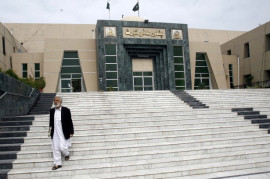
LAHORE: There is no reduction expected in load-shedding within the next two years, according to a fact sheet released by the Institute for Policy Reforms (IPR).
IPR, a think tank governed by former finance minister Hafiz A Pasha, issued the fact sheet on Thursday regarding the state of the power sector.
Based on National Electric Power Regulatory Authority’s (Nepra) recently released State of Industry Report 2014, the fact sheet provides important information about the sector that has stymied economic growth of the country.

As per estimates of the fact sheet, load-shedding remained at the highest level in 2013-14 and the gap during peak demand exceeded 4,500 megawatts.
Average duration of daily load-shedding was as high as 10 hours in Multan and Quetta, three hours in Gujranwala and Lahore and two hours in Karachi.
Supply of electricity to the distribution companies of Punjab showed high growth, especially in the case of Gujranwala Electric Power Company (Gepco), Multan Electric Power Company (Mepco) and Faisalabad Electric Supply Company (Fesco).

Other companies like Peshawar Electric Supply Company (Pesco), Hyderabad Electric Supply Company (Hesco) and Quetta Electric Supply Company (Qesco) saw a decline in supply.
The country saw no improvement in line losses from the transmission and distribution of power. Total line losses stood at 18.5% in 2013-14.
Some distribution companies, however, registered higher line losses. For example, line losses for the Sukkur Electric Power Company were as high as 39%.
Less-than-required recovery of consumer bills remained a major concern. The distribution companies and K-Electric combined recovered 11% less than the amount billed in 2013-14.
Lahore and Faisalabad companies performed well, while Quetta recovered less than half of the amount billed. Consequently, total arrears to be paid by consumers increased 25% and reached Rs513 billion. Of these, Rs313 billion had to be paid by private consumers, contributing significantly to the circular debt.
Over-charging of bills became a major concern in 2013-14. The number of complaints received from the consumers increased to 3.4 million in the year, most of which were pertaining to overcharging. The highest number of complaints was from Karachi, Lahore and Gujranwala.
The fact sheet recognised a modest increase of 550MW in the installed power generation capacity in the year. Most of the increase was recorded in thermal power generation, in which furnace oil had a share of 61% as fuel source.
Despite the increase in power production, load-shedding is expected to continue well into 2019, inflicting a high cost of 3.7% of GDP to the economy.
Published in The Express Tribune, February 27th, 2015.
Like Business on Facebook, follow @TribuneBiz on Twitter to stay informed and join in the conversation.























































COMMENTS (1)
Comments are moderated and generally will be posted if they are on-topic and not abusive.
For more information, please see our Comments FAQ